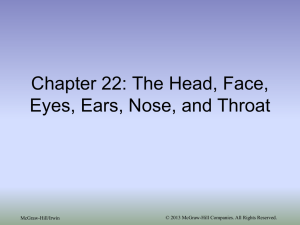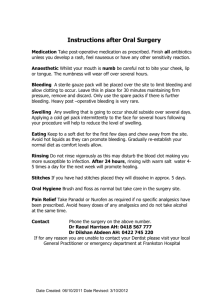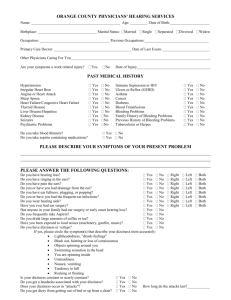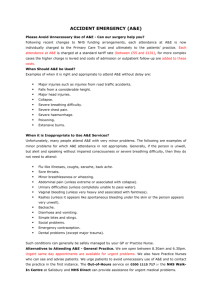Chapter 27: The Head, Face, Eyes, Ears, Nose and Throat
advertisement
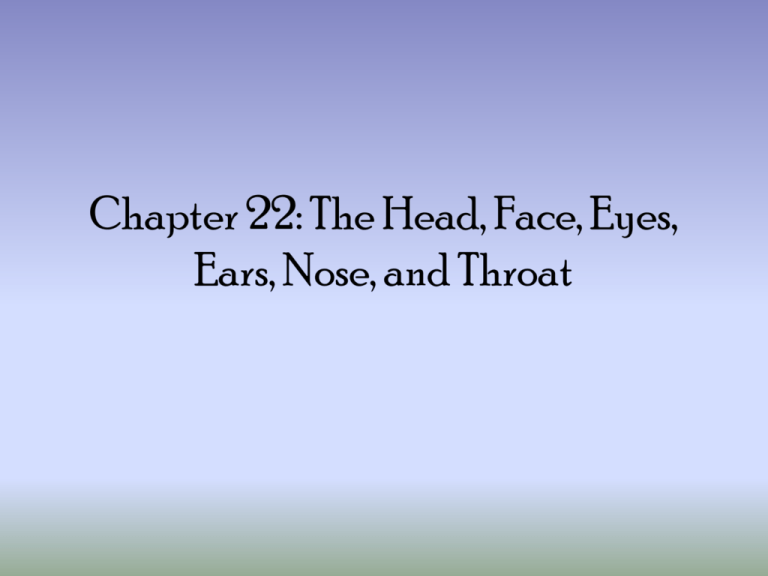
Chapter 22: The Head, Face, Eyes, Ears, Nose, and Throat Prevention of Injuries to the Head, Face, Eyes, Ears, Nose, and Throat • Head and face injuries are prevalent in sport, particularly in collision and contact sports • Education and protective equipment are critical in preventing injuries to the head and face • Head trauma results in more fatalities than any other sports injury • Morbidity and mortality associated w/ brain injury have been labeled the silent epidemic Assessment of Head Injuries • Brain injuries occur as a result of – – – – direct blow sudden hyperextension Sudden hyperflexion Sudden rotation • Often athlete experiences – – – – Loss of consciousness, Disorientation, Motor coordination or balance deficits and cognitive deficits Amnesia • Retrograde and anterograde • May present as life-threatening injury or cervical injury (if unconscious) • History – Determine loss of consciousness and amnesia – Additional questions (response will depend on level of consciousness) • Amnesia questions– Start at most recent and work backwards – Begin with walking off the field, progress to last play, and move further into the past • Does your head hurt? • Do you have pain in your neck? • Can you move your hands and feet? • Observation – Is there any swelling or bleeding from the scalp? – Is there cerebrospinal fluid in the ear canal? – Is the athlete disoriented and unable to tell where he/she is, what time it is, what date it is and who the opponent is? – Is there a blank or vacant stare? Can the athlete keep their eyes open? – – – – Is there slurred speech or incoherent speech? Are there delayed verbal and motor responses? Gross disturbances to coordination? Inability to focus attention and is the athlete easily distracted? – Memory deficit? – Does the athlete have normal cognitive function? – Normal emotional response? • Palpation – Neck and skull for point tenderness and deformity • Special Tests – Neurologic exam • Assess cerebral testing, cranial nerve testing, cerebellar testing, sensory and reflex testing – Eye function • Pupils equal round and reactive to light (PEARL) – Dilated or irregular pupils – Ability of pupils to accommodate to light variance • Eye tracking - smooth or unstable (nystagmus, which may indicate cerebral involvement) • Blurred vision – Balance Tests • Romberg Test – Assess static balance determine individual’s ability to stand and remain motionless – Tandem stance is ideal • BESS – Balance Error Scoring System – Coordination tests • Finger to nose, heel-to-toe walking • Inability to perform tests may indicate injury to the cerebellum – Cognitive Tests • Used to establish impact of head trauma on cognitive function and to obtain objective measures to assess patient status and improvement • On or off-field assessment – Serial 7’s, months in reverse order, counting backwards – Tests of recent memory (score of contest, 3 word recall) • Neuropsychological Assessments – Standardized Assessment of Concussion (SAC) provides immediate objective data concerning presence and severity of neurocognitive impairment Recognition and Management of Specific Head Injuries • Skull Fracture – Cause of Injury • Most common cause is blunt trauma – Signs of Injury • Severe headache and nausea • Palpation may reveal defect in skull • May be blood in the middle ear, ear canal, nose, ecchymosis around the eyes (raccoon eyes) or behind the ear (Battle’s sign) • Cerebrospinal fluid may also appear in ear and nose – Care • Immediate hospitalization and referral to neurosurgeon • Concussions (Mild Head Injuries) • Characterized by immediate and transient posttraumatic impairment of neural function – Cause of Injury • Result of direct blow, acceleration/deceleration forces producing shaking of the brain – Coup mechanism – Contra-coup mechanism – Signs of Injury • Brief periods of diminished consciousness or unconsciousness that lasts seconds or minutes • Headache, tinnitus, nausea, irritability, confusion, disorientation, dizziness, posttraumatic amnesia, retrograde amnesia, concentration difficulty, blurred vision, photophobia, sleep disturbances – Care • The decision to return an athlete to competition following a brain injury is a difficult one that takes a great deal of consideration • If any loss of consciousness occurs the ATC must remove the athlete from competition • With any loss of consciousness (LOC) a cervical spine injury should be assumed • Objective measures (BESS and SAC) should be used to determine readiness to play • A number of guidelines have been established in an effort to aid clinicians in their decisions – Care (continued) • All post-concussive symptoms should be resolved prior to returning to play -- any return to play should be gradual • Athlete must be cleared by the team physician • Recurrent concussions can produce cumulative traumatic injury to the brain – Second Impact Syndrome • Following an initial concussion the chances of a second episode are 3-6 times greater • Postconcussion Syndrome – Cause of Injury • Condition which occurs following a concussion • May be associated w/ those MHI’s that don’t involve a LOC or in cases of severe concussions – Signs of Injury • Athlete complains of a range of postconcussion problems – Persistent headaches, impaired memory, lack of concentration, anxiety and irritability, giddiness, fatigue, depression, visual disturbances • May begin immediately following injury and may last for weeks to months – Care • ATC should treat symptoms to greatest extent possible • Return athlete to play when all signs and symptoms have fully resolved • Second Impact Syndrome – Cause of Injury • Result of rapid swelling and herniation of brain after a second head injury before symptoms of the initial injury have resolved • Second impact may be relatively minimal and not involve contact w/ the cranium • Impact disrupts the brain’s blood autoregulatory system leading to swelling, increasing intracranial pressure – Signs of Injury • Often athlete does not LOC and may looked stunned • Within 15 seconds to several minutes of injury athlete’s condition degrades rapidly – Dilated pupils, loss of eye movement, LOC leading to coma, and respiratory failure • Second Impact Syndrome (continued) – Care • Life-threatening injury that must be addressed w/in 5 minutes w/ life saving measures performed at an emergency facility • Best management is prevention from the ATC’s perspective – Do not return an athlete to activity if symptoms still persist from the original injury • Epidural Hematoma – Cause of Injury • Blow to head or skull fracture which tear meningeal arteries • Blood pressure, blood accumulation and creation of hematoma occur rapidly (minutes to hours) – Signs of Injury • LOC followed by period of lucidity, showing few signs and symptoms of serious head injury • Gradual progression of S&S – Head pains, dizziness, nausea, dilation of one pupil (anascoria) (occurs on same side as injury), deterioration of consciousness, neck rigidity, depression of pulse and respiration, and convulsion – Care • Requires urgent neurosurgical care; CT is necessary for diagnosis • Must relieve pressure to avoid disability or death • Subdural Hematoma – Cause of Injury • Result of acceleration/deceleration forces that tear vessels that bridge dura mater and brain • Venous bleeding (simple hematoma may result in little to no damage to cerebellum while more complicated bleed can damage cortex) – Signs of Injury • Athlete may experience LOC, dilation of one pupil • Signs of headache, dizziness, nausea or sleepiness – Care • Immediate medical attention • CT or MRI is necessary to determine extent of injury Epidural Hemotoma Subdural Hemotoma • Scalp Injuries – Cause of Injury • Blunt trauma or penetrating trauma tends to be the cause • Can occur in conjunction with serious head trauma – Signs of Injury • Athlete complains of blow to the head • Bleeding is often extensive (difficult to pinpoint exact site) – Care • • • • • Clean w/ antiseptic soap and water (remove debris) Cut away hair if necessary to expose area Apply firm pressure or astringent to reduce bleeding Wounds larger than 1/2 inch in length should be referred Smaller wounds can be covered w/ protective covering and gauze (use extra adherent) Recognition and Management of Specific Facial Injuries Recognition and Management of Specific Facial Injuries • Mandible Fractures – Cause of Injury • Direct blow (generally fractures at frontal angle) – Signs of Injury • • • • • Pain with biting Deformity Loss of occlusion bleeding around teeth lower lip anesthesia – Care • Temporary immobilization w/ elastic wrap followed by reduction and fixation • Zygomatic complex (cheekbone) fracture – Cause of Injury • Direct blow – Signs of Injury • • • • Deformity, or bony discrepancy, Nosebleed, Diplopia, Cheek numbness – Care • Cold application to control edema and immediate referral to a physician • Healing will take 6-8 weeks and proper gear will be required upon return to play • Facial Lacerations – Cause of Injury • Result of a direct impact, and indirect compressive force or contact w/ a sharp object – Signs of Injury • Pain • Substantial bleeding – Care • Apply pressure to control bleeding • Referral to a physician will be necessary for stitches Recognition and Management of Specific Dental Injuries Prevention of Dental Injuries • When engaged in contact/collision sports mouth guards should be worn – Greatly reduces the incidence of oral injuries • • • • Practice good dental hygiene Dental screenings should occur yearly Cavity prevention Prevention of abscess development, gingivitis, and periodontitis • Tooth Fractures – Cause of Injury • Impact to the jaw, • Direct dental trauma – Signs of Injury • Uncomplicated fractures produce fragments w/out bleeding • Complicated fractures produce bleeding, w/ the tooth chamber being exposed w/ a great deal of pain • Root fractures are difficult to determine and require follow-up w/ X-ray • Tooth Fractures (continued) – Care • Uncomplicated and complicated crown fractures do not require immediate attention – Fractured pieces can be placed in a bag, milk, or save-a-tooth solution. DO NOT place the avulsed tooth portion in ice – If not sensitive to air or cold, follow-up can wait orthodontist within 24-48 hours – Bleeding can be controlled via gauze – Cosmetic reconstruction of tooth • In instances of root fractures, the athlete can continue to play but must follow-up immediately following competition – Tooth repositioning may be required, along with bracing and the use of mouthpieces in the future • Tooth Subluxation, Luxation and Avulsion – Cause of Injury • Direct blow – Signs of Injury • Tooth may be slightly loosened or dislodged • When subluxed tooth may be loose w/in socket w/ little or no pain • With luxations, no fracture has occurred, however, there is displacement • With an avulsion, the tooth is completely knocked from the oral cavity – Care • For a subluxed tooth, referral should occur w/in the first 48 hours • With a luxated tooth, repositioning should be attempted along w/ immediate follow-up • Avulsed teeth should not be re-implanted except by a dentist (use a Save a Tooth Kit, milk or saline) Nasal Injuries • Nasal Fractures and Chondral Separation – Cause of Injury • Direct trauma – Signs of Injury • Separation of frontal processes of maxilla, • Separation of lateral cartilage or combination • Profuse bleeding and hemorrhaging, • Immediate swelling and deformity • Care – Control bleeding and refer to a physician for X-ray,examination and reduction – Uncomplicated and simple fractures will pose little problem for the athlete’s quick return – Splinting may be necessary • Deviated Septum – Cause of Injury • Compression or lateral trauma – Signs of Injury • Bleeding and in some instances a septal hematoma • Athlete will complain of nasal pain – Care • At the site of the hematoma, compression will be required (and if present, drained immediately) • Following drainage, a wick is inserted to allow for further drainage • Packing will be necessary to prevent a return of the hematoma • A neglected hematoma will result in formation of an abscess along with bone and cartilage loss and deformity • Nosebleed (epistaxis) – Cause of Injury • • • • • Result of a direct blow Sinus infection High humidity Allergies A foreign body or some other serious facial injury – Signs of Injury • Generally bleeding from the anterior aspect of the septum • Generally presents with minimal bleeding and resolves spontaneously • More severe bleeding may require more medical attention – Care • W/ acute bleeding, sit upright w/ a cold compress over the nose, pressure on the affected nostril and the ipsilateral carotid artery – Also gauze between the upper lip and gum - limits blood supply • If bleeding does not cease in 5 minutes, an astringent or styptic may need to be applied along with a gauze/cotton nose plug to encourage clotting • After bleeding has ceased, the athlete can return to play but should be reminded not to blow the nose under any circumstances for at least 2 hours after the initial insult Recognition and Management of Specific Ear Injuries Recognition and Management of Specific Ear Injuries • Auricular Hematoma (Cauliflower Ear) – Cause of Injury • Occurs either from compression or shear injury to the ear (single or repeated) • Causes subcutaneous bleeding • Auricular Hematoma (Cauliflower Ear) – Signs of Injury • Tearing of overlying tissue away from cartilage • Hemorrhaging and fluid accumulation • If unattended - coagulation, organization and fibrosis occurs – Appears as elevated, white, rounded nodular formation, that is firm and resembles cauliflower – Care • To prevent, wear proper ear protection • Cold application will minimize hemorrhaging • If swelling occurs, measures must be taken to prevent fluid solidification – Physician aspiration, packing, pressure, keloid removal if necessary • Rupture of the Tympanic Membrane – Cause of Injury • Fall or slap to the unprotected ear or sudden underwater variation can result in a rupture – Signs of Injury • Complaint of loud pop, followed by pain in ear, nausea, vomiting, and dizziness • Hearing loss, visible rupture (seen through otoscope) – Care • Small to moderate perforations usually heal spontaneously in 1-2 weeks • Infection can occur and must be continually monitored • Should not fly until condition is resolved Rupture Tympanic Membrane • Swimmer’s Ear (Otitis Externa) – Cause of Injury • Infection of the ear canal caused be a gram-negative bacillus • Water becomes trapped by a cyst, bone growths, earwax plugs or swelling caused by allergies – Signs of Injury • Pain and dizziness, itching, discharge and even partial hearing loss – Care • Prevent by drying ear with a soft towel, use ear drops with boric acid and alcohol before and after swimming • Avoid things that might cause infection, overexposure to cold wind or sticking foreign objects into the ear • Physician referral will be necessary for antibiotics, acidification of the environment to kill bacteria and to rule out tympanic membrane rupture • Middle Ear Infection (Otitis Media) – Cause of Injury • Accumulation of fluid in the middle ear caused by local and systemic infection and inflammation – Signs of Injury • Intense pain in the ear, fluid drainage from the ear canal, transient hearing loss • Systemic infection may also cause a fever, headaches, irritability, loss of appetite, and nausea – Care • Fluid withdrawal may be necessary to determine the appropriate antibiotics • Analgesics for pain • Generally resolves in 24 hours while pain may last for 72 hours Recognition and Management of Specific Eye Injuries Recognition and Management of Specific Eye Injuries • Over 100,000 Sport related ocular injuries occur each year • Aspects associated with sport-related ocular injuries – High likelihood of being a severe injury – Treatment often limited to salvaging the remaining vision – Most can be prevented • Vision is the most dominant sense – 70% of sensory receptors – 40% of cerebral cortex Recognition and Management of Specific Eye Injuries • Orbital Hematoma (Black Eye) – Cause of Injury • Blow to the area surrounding the eye – Signs of Injury • Signs of a more serious condition may be displayed as a subconjunctival hemorrhage • Swelling and discoloration – Care • Cold application for at least 30 minutes, • 24 hours of rest if athlete has distorted vision • Do not blow nose after acute eye injury – may increase hemorrhaging • Orbital Fracture – Cause of Injury • Direct trauma to the eyeball – Signs of Injury • • • • • • Blurred vision Diplopia Restricted eye movement Downward displacement of the eye Soft-tissue swelling and hemorrhaging Numbness – Infraorbital nerve entrapment – Care • X-ray will be necessary to confirm fracture • Antibiotics – Decrease risk of infection (due to proximity of maxillary sinus and bacteria) • Treat surgically or allow to resolve spontaneously Orbital Fracture • Corneal Abrasions – Cause of Injury • Attempt to remove foreign object from eye by rubbing Signs of Injury – Signs of injury • • • • • • Mild to severe pain Watering of the eye Photophobia Pain with blinking Decreased focusing ability Spasm of the orbicular muscle of the eyelid – Care • Patch eye and refer to a physician • Antibiotic ointment is applied with a semi-pressure patch over the closed eyelid (prescribed by physician) • Hyphema – Cause of Injury • Direct trauma to eye • Major injury that – lead to serious problems with the lens, choroid or retina – Signs of Injury • collection of blood in anterior chamber of the eye • Visible reddish tinge in anterior chamber (blood may turn pea green) • Vision is partially or completely blocked – Care • IMMEDIATE referral to an ophthalmologist • Bed rest and elevation (30-40 degrees); both eyes patched; sedation; and medication to reduce anterior chamber pressure • Occasionally additional bleeding will occur Hyphema • Retinal Detachment – Cause of Injury • Blow to the eye can partially or completely separate the retina from the underlying retinal pigment epithelium – Signs of Injury • • • • • Painless, Flash of light Curtain falling over the eye May report floating specks Blurred vision – Care • Immediate referral to an ophthalmologist • Bed rest, patches for both eyes Retinal Detachment • Acute Conjunctivitis – Cause of Injury • Bacterial infection • Allergies • Conjunctival irritation caused by wind, dust, smoke, or air pollution • Associated with common cold or upper respiratory conditions – Signs of Injury • Eyelid swelling w/ purulent discharge • Itching associated with an allergy • Burning or itching – Care • Highly infectious • Refer to physician for treatment Conjunctivitis
